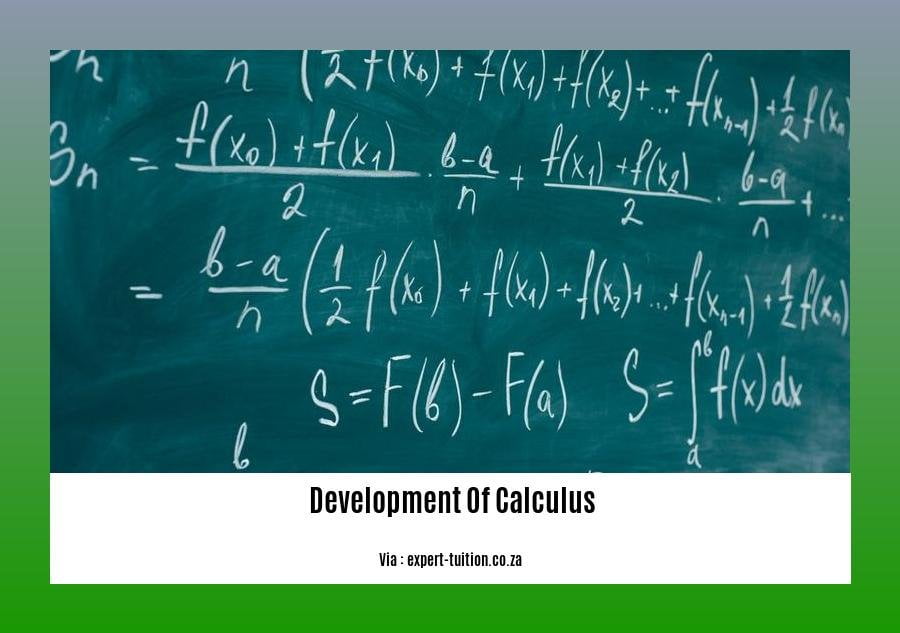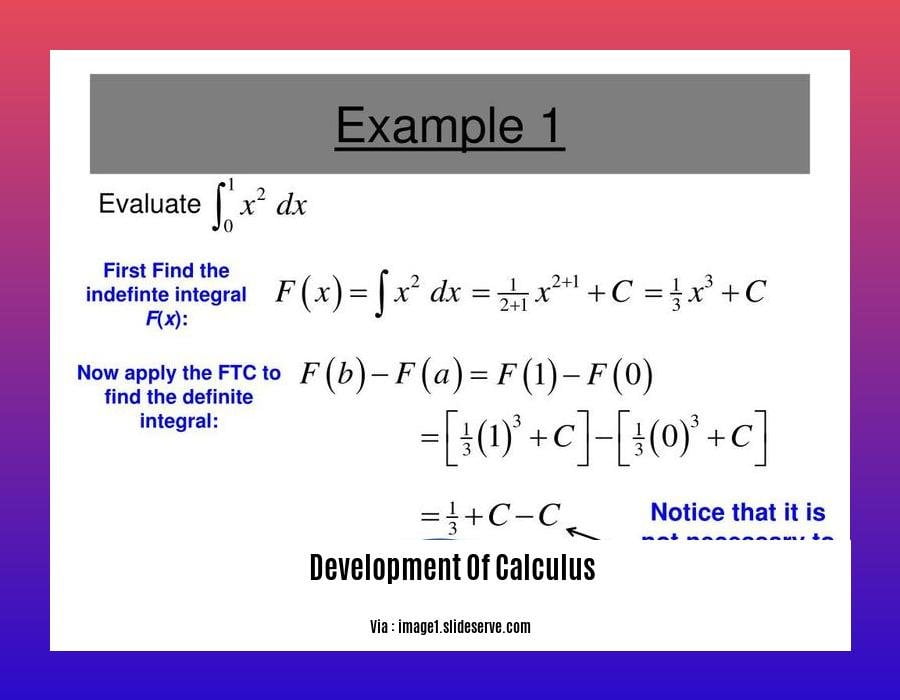Embark on a captivating journey through the development of calculus in [- The Development of Calculus: A Historical Perspective on a Transformative Mathematical Tool]. This article delves into the origins, evolution, and profound impact of calculus, a cornerstone of modern mathematics and scientific discovery.
Key Takeaways:
- Calculus emerged in the late 17th century, primarily due to the work of Newton and Leibniz.
- Calculus has its roots in ancient mathematical practices and evolved over time.
- Newton’s contributions focused on applying calculus to physical systems.
- Leibniz developed the widely used notations associated with calculus.
Development of Calculus

Calculus, a cornerstone of modern mathematics, emerged in the development of calculus as a revolutionary tool that transformed our understanding of change and continuous processes. As we delve into its rich history, we uncover the pivotal contributions of brilliant minds who shaped its foundation.
Ancient Precursors
Though the development of calculus reached its zenith in the 17th century, its roots extend to ancient civilizations. Babylonians and Egyptians devised methods for calculating areas and volumes, while Greek mathematicians like Archimedes explored concepts of infinitesimals. The concept of “fluxions,” a precursor to derivatives, was hinted at by Islamic scholars like Hasan Ibn al-Haytham.
The Birth of Calculus
The development of calculus gained momentum in the 17th century with the independent work of Isaac Newton and Gottfried Leibniz. Newton, driven by his studies in physics, developed calculus to analyze motion and gravitation. Leibniz, on the other hand, focused on notation and systematized the subject, introducing the familiar symbols we use today, like “dy/dx” for derivatives and “∫” for integrals.
Key Milestones
The development of calculus proceeded through several groundbreaking milestones:
- Newton’s Method of Fluxions (1666): A technique for finding derivatives and integrals
- Leibniz’s Notation (1684): Standardized notation that simplified calculations
- Cauchy’s Epsilon-Delta Definition (1821): A rigorous foundation for limits and derivatives
- Weierstrass’s Epsilon-Delta Definition (1861): A more precise definition that paved the way for modern analysis
Impact and Legacy
The development of calculus had a profound impact on mathematics, science, and engineering. It enabled:
- Precise analysis of motion, forces, and other physical phenomena
- Development of differential and integral equations to model complex systems
- Creation of new mathematical techniques, such as optimization and Fourier analysis
Calculus remains a vital tool in fields as diverse as physics, engineering, economics, and computer science. Its enduring legacy testifies to the transformative power of human ingenuity and the unwavering pursuit of understanding the world we inhabit.
Dive into the captivating history of mathematics and unveil the fascinating evolution of numerical systems throughout the ages. Explore the ancient numeral systems and marvel at the ingenuity of early civilizations. Stay at the forefront of mathematical discovery by delving into the latest modern mathematical theories and witness the groundbreaking advancements that shape our understanding of the world.
The Development of Calculus in the 18th Century
In the 18th century, calculus blossomed with significant strides and refinement.
Newton’s Contributions:
Isaac Newton, an English physicist and mathematician, played a pivotal role in the development of calculus. His discovery of fluxions, a method for calculating rates of change, became the groundwork for differential calculus.
Leibniz’s Contributions:
Gottfried Leibniz, a German mathematician and philosopher, independently developed calculus around the same time as Newton. His invention of the integral sign and his systematic development of integral calculus complemented Newton’s work.
Fundamental Theorems of Calculus:
The First Fundamental Theorem of Calculus:
It established the connection between differentiation and integration, showing that the integral of a derivative is the original function.
The Second Fundamental Theorem of Calculus:
It provided a powerful tool for finding the area under a curve by relating it to the definite integral of the function defining the curve.
Key Takeaways:
- The 18th century marked a pivotal era in the Development of Calculus in the 18th Century.
- Newton’s fluxions and Leibniz’s integral sign were major milestones.
- The Fundamental Theorems of Calculus solidified the foundations of calculus.
Citations
- TakeLessons: Calculus
- Springer: Development of Calculus
Calculus in the 19th and 20th Centuries

During the 19th and 20th centuries, calculus underwent significant advancements, shaping its modern form and applications. Here are key developments:
The Formalization of Calculus
In the 19th century, mathematicians such as Cauchy, Bolzano, and Weierstrass developed rigorous foundations for calculus. They introduced the epsilon-delta definition of a limit, providing a precise mathematical basis for calculus. This formalized framework enhanced the subject’s rigor and made it more accessible for study.
Calculus and Mathematical Physics
The 19th century saw a growing connection between calculus and mathematical physics. Physicists like Maxwell and Kelvin used calculus to describe electromagnetic phenomena, thermodynamics, and wave propagation. Calculus became an essential tool for understanding and predicting physical systems.
Calculus and Analysis
In the late 19th and early 20th centuries, mathematicians developed new areas of mathematics based on calculus. Henri Lebesgue’s concept of the Lebesgue integral provided a more general framework for integrating functions, while David Hilbert’s theory of Hilbert spaces extended the use of calculus in abstract mathematics.
Calculus and Computing
In the 20th century, the advent of electronic computers revolutionized calculus. Numerical methods, such as finite difference methods, enabled the solution of complex calculus problems. Computer-aided symbolic computation systems also emerged, providing powerful tools for manipulating and solving calculus equations.
Key Takeaways:
- Calculus underwent rigorous formalization in the 19th century, providing a solid mathematical foundation.
- The 19th century witnessed the integration of calculus into mathematical physics, enabling the description of physical systems.
- New areas of mathematics developed in the late 19th and early 20th centuries, expanding the applications of calculus.
- Computing technology in the 20th century revolutionized calculus, allowing for the numerical and symbolic computation of complex problems.
Relevant URL Sources
- Calculus and Mathematical Analysis
- Numerical Methods for Calculus
Applications of Calculus in Science and Engineering
Calculus: A Bridge Between Theory and Practice
For centuries, calculus has been the backbone of scientific and engineering advancements. This mathematical tool empowers us to model, analyze, and predict complex phenomena in the natural world.
1. Unveiling the Laws of Motion
Calculus helps us describe the motion of objects, from the trajectory of a thrown ball to the orbital path of a planet. By taking derivatives, we can determine velocity and acceleration, while integrals reveal displacement and area.
2. Designing Structures that Defy Gravity
Calculus is indispensable in structural engineering. It enables us to calculate stresses and strains on bridges, buildings, and aircraft. This ensures that these structures can withstand external forces and remain safe and durable.
3. Optimizing Fluid Flow
Calculus plays a crucial role in fluid dynamics. It helps engineers design pipelines, turbines, and other fluid systems that minimize energy loss and maximize efficiency. By understanding how fluids behave, we can optimize these systems for various applications.
4. Predicting Weather Patterns
Calculus is an essential tool for meteorologists. It allows them to model atmospheric conditions, predict weather patterns, and forecast potential storms. By analyzing data and applying calculus techniques, meteorologists can provide timely warnings and ensure public safety.
5. Unlocking the Secrets of Biology
Calculus finds its way even into biology. It helps researchers model population growth, enzyme kinetics, and other biological processes. By analyzing data and applying calculus, scientists can make informed decisions and advance our understanding of life.
Key Takeaways:
- Calculus is a powerful tool used in various scientific and engineering disciplines.
- It enables us to model, analyze, and predict complex phenomena in the natural world.
- Applications of calculus include motion analysis, structural design, fluid optimization, weather forecasting, and biological modeling.
Relevant URL Sources:
- Applications in Science and Engineering
- Calculus in Engineering
FAQ
Q1: When was calculus first developed?
A1: Calculus was first developed in the late 17th century by Isaac Newton and Gottfried Leibniz.
Q2: Who are some key contributors to the development of calculus?
A2: Key contributors to the development of calculus include Isaac Newton, Gottfried Leibniz, Pierre de Fermat, and Augustin-Louis Cauchy.
Q3: What are the main applications of calculus?
A3: Calculus has a wide range of applications in science, engineering, and economics. It is used to solve problems in areas such as motion, optimization, and fluid dynamics.
Q4: How has calculus impacted our understanding of the world?
A4: Calculus has played a crucial role in our understanding of the physical world. It has allowed us to develop navigation systems, predict the weather, and design bridges and buildings.
Q5: How can I learn more about the history of calculus?
A5: There are many resources available to learn more about the history of calculus. You can find books, articles, and websites that discuss the development of calculus and its impact on mathematics and science.
- Sept 31 Myth: Unveiling Calendar Secrets - March 18, 2025
- How Long & Till December 18, 2025: Accurate Countdown Guide - March 18, 2025
- Discover Japanese Artists: A Complete History - March 18, 2025
















